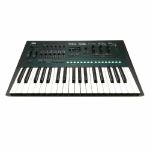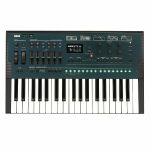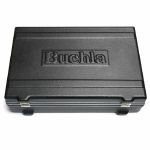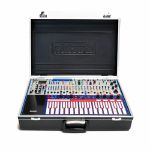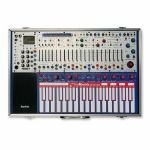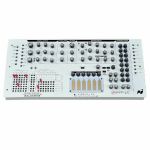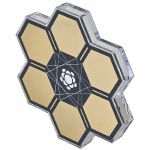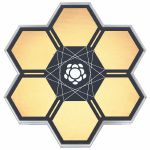100% Sicheres Einkaufen
Studio equipment
Our full range of studio equipment from all the leading equipment and software brands. Guaranteed fast delivery and low prices.
100% Sicheres Einkaufen
DJ equipment
Our full range of DJ equipment from all the leading equipment and software brands. Guaranteed fast delivery and low prices. Visit Juno DJ
Filter
Stock
Coming Soon
Equipment
Format
Featured
Price
Tags
Artikel 1 bis 5 von 5 auf Seite 1 von 1 anzeigen
Korg Opsix MK2 64-Voice Polyphonic Altered FM Synthesiser (B-STOCK) (digital keyboard synthesiser)
Cat: 1015210 Rel: 01 Jan 90
B-STOCK: Box damaged, product in perfect working order
Notes: ***B-STOCK: Box damaged, product in perfect working order***
Second-gen version of the excellent Opsix features major updates including 64-voice polyphony and an improved interface. Same powerful six-operator FM synth engine.
Supplier's Notes:
A Full-Spectrum Sound Experience
Opsix mk II is a digital synth like no other. Based on the sound engine of the original Opsix, the number of simultaneous voices and voicings has been expanded to an astounding 64 voices. The result is superior performance and precise control.
The Opsix Operator Mixer simplified FM synthesis for the first time, making it not just comprehensible but also controllable. With the addition of extra synthesis capabilities and programming, it offered a more efficient workflow and an even richer sound.
And, it is fully compatible with the sounds and samples from both the original opsix and the opsix Native software, including numerous high-quality libraries.
Evolved to an astounding 64 voices
The Opsix mk II has 64 voices, twice as many as the original 32 voices, allowing users to enjoy tone editing without having to worry about the number of simultaneous voices. In addition, the operator-mixer section, the most distinctive feature of this product, has been accented with a new image colour, green.
Get Illuminated with the Operator Mixer
At the heart of every sound is Opsix mk II's Operator Mixer - a simple set of six faders and knobs that invite exploration. Each part lights up red to indicate carriers or blue for modulators. Manipulating them opens up new sound-shaping possibilities to breathe fresh life into your musical ideas. This straightforward, hands-on workflow is part of what makes Opsix mk II so unique, just like the sounds it offers.
Direct Hands-On Control
Whether you're tweaking a preset or building a patch from the ground up, the six data entry knobs on the right give you quick access to the parameters you need and seamlessly sync with the large OLED display, giving you a clear, focused direction to your workflow. Coupled with the mixer, it makes creating fresh sounds super easy and, most importantly, fun!
Select from a full range of analogue-style filters, from the radical Korg MS-20 low-pass/high-pass filter to the powerful yet smooth KORG Polysix low-pass filter that gives your sound a vintage feel. There are also two or four-pole low-pass, high-pass, band-pass, and band-reject filters with resonance.
There's even a built-in spectrum analyser and oscilloscope that gives you visual feedback via the screen on the music you're making.
Six in One Synthesis
The core of Opsix mk II is nothing short of exponential. Since waveforms can be arranged and modulated in nearly infinite ways, Opsix mk II can easily do the sonic work that is similar to numerous types of synthesis:
Subtractive
Removing parts of the sound to get the sound you want; the most widely-used synthesis. Opsix mk II uses up to six envelopes and multi-modelled filters to achieve many cutting-edge and classical analogue synthesis tones.
Semi-Modular
Rerouting signal paths to change the sound. A spin through the Algorithm section will dramatically reshape the sound by changing how the signal routing between the operators work together, and no patch cables are needed. Analog-style controls and plenty of stackable waveforms take you from digital to analogue-sounding in no time. Enjoy deep basses, crisp leads, thick pad sounds, fuzzy brass tones, and so much more.
Analogue (Modeling)
Analogue-style controls and plenty of stackable waveforms take you from digital to analogue-sounding in no time. Enjoy deep basses, crisp leads, thick pad sounds, fuzzy brass tones, and so much more.
Waveshaping
Adding intentional distortion to the waveforms to achieve aggressive overtones that are either harmonic or inharmonic. This will help you achieve gritty, bitey tones dripping with character.
Additive
Stacking waveforms and blending their harmonics is key to an expansive range of harmonious, dissonant, and tension-driven sounds. With six operators available, the complete FM experience is possible, including the ability to go back in time for classic sounds you have heard throughout recording history.
Classic FM
Last but certainly not least, Opsix's highly flexible and powerful architecture starts with true six-Operator FM. As a result, it easily delivers signature sounds you have surely heard on thousands of hits from the '80s on through today, and with far more polyphony than other standalone FM synths available today.
With all of these ways to realize and explore sounds, Opsix mk II is uniquely suited as a "future-modern-classic" synth!
Altered Reality
What started as a legacy synthesis has evolved into something completely different. Opsix mk II is FM-based, but the similarities to the classic synthesis end there. The Altered FM architecture delivers sounds across a vast spectrum, far wider than any single synthesis has been able to cover before, thanks to new sound components; new waveforms, filters, shaping, effects, LFOs, envelopes, modulations, and more, all translating to its broad assortment of sounds.
Powerful Effects Processing
Opsix mk II provides three blocks of 30 types of high-definition effects that you can use together to enhance your sounds even further. There's everything from a great mix of usable standard effects like chorus, phaser, delay, and compressor to some world-class shimmering reverbs that will elevate your sound to the next level.
Specifications
Keyboard: 37 keys (velocity and release-velocity sensitive)
Sound generating system: Altered FM sound generator
Maximum Polyphony: 64 voices (varies depending on the setting)
Structure: 6 operators, 1 filter, 3 EGs, 3 LFOs, 3 effects, step sequencer, arpeggiator
Algorithm: 40 presets + user algorithm (unique to each program)
Operator: 6 modes (FM, Ring Mod., Filter, Filter FM, Wave Folder, Effect)
Oscillator waveform: 23 waveforms (Sine, Sine 12bit, Sine 8bit, Triangle, Saw, Saw HD, Square, Square HD, Additive Saw3, Additive Sqr3, Additive Tri3, Additive 12345, Additive 1+2, Additive 1+3, Additive 1+4, Additive 1+5, Additive 1+6, Additive 1+7, Additive 1+8, Noise S/H, Noise White, Noise Pink, Noise Blue)
Filter: 11 types (LPF 12, LPF 24, LPF MS-20, LPF POLY6, HPF 12, HPF 24, HPF MS-20, BPF 6, BPF 12, BRF 6, BRF 12)
EG: ADSR
LFO: 23 waveforms (Triangle, Saw Down, Saw Up, Square, Sine, Sample&Hold, Guitar, Exp. Triangle, Exp. Saw Down, Exp. Saw Up, Step4 Triangle, Step6 Triangle, Step4 Saw Down, Step6 Saw Down, StepRnd:Time, StepRnd:Lvl&Time, StepRnd:Level, Random:Time, Random:Lvl&Time, Triangle + , Saw Down + , Saw Up + , Square +)
V.Patch: 12 routings
Effect: 30 types (Chorus, Unison Ensemble, Phaser, Phaser (BPM) , Auto Pan, Auto Pan (BPM), Flanger, Flanger (BPM) , Rotary Speaker, Auto Wah, Exciter, Enhancer, LFO Filter, 3-Band EQ, Distortion, Guitar Amp, Decimator, Grain Shifter, Master Limiter, Compressor, Delay, Delay (BPM) , Autopan Dly, Autopan Dly (BPM), Tape Echo, Tape Echo (BPM) , Early Reflection, Reverb, Shimmer Reverb, Spring Reverb)
Sequencer: Step Sequencer (up to 16 steps, up to 6 notes per step), Motion Sequencer (up to 6 lanes)
Arpeggiator: 7 patterns (MANUAL, UP, DOWN, ALT1, ALT2, RANDOM, TRIGGER)
Number of programs: 500 (350 preset programs and 150 user programs as the factory-set default)
Favourite: 64 (16 Slots × 4 Banks)
Controllers: MODULATION wheel, PITCH wheel, RATIO OP 1-6 knobs, LEVEL OP 1-6 sliders, DATA ENTRY A-F knobs
Inputs/outputs: Headphone (6.3 mm stereo phone jack), OUTPUT L/MONO and R (impedance-balanced 6.3 mm TRS phone jacks), DAMPER (6.3 mm phone jack, half-damper not supported), MIDI IN and OUT connectors, USB B port
Power supply: AC adapter (DC12V)
Power consumption: 5 W
Dimensions (W × D × H): 565 × 338 × 90 mm / 22.24" × 13.31" × 3.54"
Weight: 2.9 kg / 6.93 lbs.
Included items: AC adapter
Accessories (sold separately): DS-1H damper pedal, PS-1 pedal switch, PS-3 pedal switch
… Read moreSecond-gen version of the excellent Opsix features major updates including 64-voice polyphony and an improved interface. Same powerful six-operator FM synth engine.
Supplier's Notes:
A Full-Spectrum Sound Experience
Opsix mk II is a digital synth like no other. Based on the sound engine of the original Opsix, the number of simultaneous voices and voicings has been expanded to an astounding 64 voices. The result is superior performance and precise control.
The Opsix Operator Mixer simplified FM synthesis for the first time, making it not just comprehensible but also controllable. With the addition of extra synthesis capabilities and programming, it offered a more efficient workflow and an even richer sound.
And, it is fully compatible with the sounds and samples from both the original opsix and the opsix Native software, including numerous high-quality libraries.
Evolved to an astounding 64 voices
The Opsix mk II has 64 voices, twice as many as the original 32 voices, allowing users to enjoy tone editing without having to worry about the number of simultaneous voices. In addition, the operator-mixer section, the most distinctive feature of this product, has been accented with a new image colour, green.
Get Illuminated with the Operator Mixer
At the heart of every sound is Opsix mk II's Operator Mixer - a simple set of six faders and knobs that invite exploration. Each part lights up red to indicate carriers or blue for modulators. Manipulating them opens up new sound-shaping possibilities to breathe fresh life into your musical ideas. This straightforward, hands-on workflow is part of what makes Opsix mk II so unique, just like the sounds it offers.
Direct Hands-On Control
Whether you're tweaking a preset or building a patch from the ground up, the six data entry knobs on the right give you quick access to the parameters you need and seamlessly sync with the large OLED display, giving you a clear, focused direction to your workflow. Coupled with the mixer, it makes creating fresh sounds super easy and, most importantly, fun!
Select from a full range of analogue-style filters, from the radical Korg MS-20 low-pass/high-pass filter to the powerful yet smooth KORG Polysix low-pass filter that gives your sound a vintage feel. There are also two or four-pole low-pass, high-pass, band-pass, and band-reject filters with resonance.
There's even a built-in spectrum analyser and oscilloscope that gives you visual feedback via the screen on the music you're making.
Six in One Synthesis
The core of Opsix mk II is nothing short of exponential. Since waveforms can be arranged and modulated in nearly infinite ways, Opsix mk II can easily do the sonic work that is similar to numerous types of synthesis:
Subtractive
Removing parts of the sound to get the sound you want; the most widely-used synthesis. Opsix mk II uses up to six envelopes and multi-modelled filters to achieve many cutting-edge and classical analogue synthesis tones.
Semi-Modular
Rerouting signal paths to change the sound. A spin through the Algorithm section will dramatically reshape the sound by changing how the signal routing between the operators work together, and no patch cables are needed. Analog-style controls and plenty of stackable waveforms take you from digital to analogue-sounding in no time. Enjoy deep basses, crisp leads, thick pad sounds, fuzzy brass tones, and so much more.
Analogue (Modeling)
Analogue-style controls and plenty of stackable waveforms take you from digital to analogue-sounding in no time. Enjoy deep basses, crisp leads, thick pad sounds, fuzzy brass tones, and so much more.
Waveshaping
Adding intentional distortion to the waveforms to achieve aggressive overtones that are either harmonic or inharmonic. This will help you achieve gritty, bitey tones dripping with character.
Additive
Stacking waveforms and blending their harmonics is key to an expansive range of harmonious, dissonant, and tension-driven sounds. With six operators available, the complete FM experience is possible, including the ability to go back in time for classic sounds you have heard throughout recording history.
Classic FM
Last but certainly not least, Opsix's highly flexible and powerful architecture starts with true six-Operator FM. As a result, it easily delivers signature sounds you have surely heard on thousands of hits from the '80s on through today, and with far more polyphony than other standalone FM synths available today.
With all of these ways to realize and explore sounds, Opsix mk II is uniquely suited as a "future-modern-classic" synth!
Altered Reality
What started as a legacy synthesis has evolved into something completely different. Opsix mk II is FM-based, but the similarities to the classic synthesis end there. The Altered FM architecture delivers sounds across a vast spectrum, far wider than any single synthesis has been able to cover before, thanks to new sound components; new waveforms, filters, shaping, effects, LFOs, envelopes, modulations, and more, all translating to its broad assortment of sounds.
Powerful Effects Processing
Opsix mk II provides three blocks of 30 types of high-definition effects that you can use together to enhance your sounds even further. There's everything from a great mix of usable standard effects like chorus, phaser, delay, and compressor to some world-class shimmering reverbs that will elevate your sound to the next level.
Specifications
Keyboard: 37 keys (velocity and release-velocity sensitive)
Sound generating system: Altered FM sound generator
Maximum Polyphony: 64 voices (varies depending on the setting)
Structure: 6 operators, 1 filter, 3 EGs, 3 LFOs, 3 effects, step sequencer, arpeggiator
Algorithm: 40 presets + user algorithm (unique to each program)
Operator: 6 modes (FM, Ring Mod., Filter, Filter FM, Wave Folder, Effect)
Oscillator waveform: 23 waveforms (Sine, Sine 12bit, Sine 8bit, Triangle, Saw, Saw HD, Square, Square HD, Additive Saw3, Additive Sqr3, Additive Tri3, Additive 12345, Additive 1+2, Additive 1+3, Additive 1+4, Additive 1+5, Additive 1+6, Additive 1+7, Additive 1+8, Noise S/H, Noise White, Noise Pink, Noise Blue)
Filter: 11 types (LPF 12, LPF 24, LPF MS-20, LPF POLY6, HPF 12, HPF 24, HPF MS-20, BPF 6, BPF 12, BRF 6, BRF 12)
EG: ADSR
LFO: 23 waveforms (Triangle, Saw Down, Saw Up, Square, Sine, Sample&Hold, Guitar, Exp. Triangle, Exp. Saw Down, Exp. Saw Up, Step4 Triangle, Step6 Triangle, Step4 Saw Down, Step6 Saw Down, StepRnd:Time, StepRnd:Lvl&Time, StepRnd:Level, Random:Time, Random:Lvl&Time, Triangle + , Saw Down + , Saw Up + , Square +)
V.Patch: 12 routings
Effect: 30 types (Chorus, Unison Ensemble, Phaser, Phaser (BPM) , Auto Pan, Auto Pan (BPM), Flanger, Flanger (BPM) , Rotary Speaker, Auto Wah, Exciter, Enhancer, LFO Filter, 3-Band EQ, Distortion, Guitar Amp, Decimator, Grain Shifter, Master Limiter, Compressor, Delay, Delay (BPM) , Autopan Dly, Autopan Dly (BPM), Tape Echo, Tape Echo (BPM) , Early Reflection, Reverb, Shimmer Reverb, Spring Reverb)
Sequencer: Step Sequencer (up to 16 steps, up to 6 notes per step), Motion Sequencer (up to 6 lanes)
Arpeggiator: 7 patterns (MANUAL, UP, DOWN, ALT1, ALT2, RANDOM, TRIGGER)
Number of programs: 500 (350 preset programs and 150 user programs as the factory-set default)
Favourite: 64 (16 Slots × 4 Banks)
Controllers: MODULATION wheel, PITCH wheel, RATIO OP 1-6 knobs, LEVEL OP 1-6 sliders, DATA ENTRY A-F knobs
Inputs/outputs: Headphone (6.3 mm stereo phone jack), OUTPUT L/MONO and R (impedance-balanced 6.3 mm TRS phone jacks), DAMPER (6.3 mm phone jack, half-damper not supported), MIDI IN and OUT connectors, USB B port
Power supply: AC adapter (DC12V)
Power consumption: 5 W
Dimensions (W × D × H): 565 × 338 × 90 mm / 22.24" × 13.31" × 3.54"
Weight: 2.9 kg / 6.93 lbs.
Included items: AC adapter
Accessories (sold separately): DS-1H damper pedal, PS-1 pedal switch, PS-3 pedal switch
1 in stock $658.17
Buchla Music Easel (Modern) Modular Analogue Synthesiser (B-STOCK) (modular analogue synthesiser)
Cat: 1014868 Rel: 01 Jan 90
B-STOCK: Item refurbished, repaired and in perfect working order.
Notes: ***B-STOCK: Item refurbished, repaired and in perfect working order.***
Celebrating the 50th anniversary of this truly iconic synth, the 'modern' take on the classic Buchla Music Easel doesn't mess with a winning formula, paring the 208C sound source with 218e touch-sensitive keyboard.
Supplier's Notes:
The Buchla Music Easel was one of the first truly portable electronic music instruments. Fifty years ago, in 1973, only a few dozen were made. Unlike many iconic technologies, the influence was not grown through force of scale, but rather the force of the ideas. The Music Easel made available virtually every musical dimension: timbre, melody, rhythm, and time; how these dimensions intersected was no longer the court of acoustics and material, but signals and voltage. The 208 Stored Program Sound Source engendered "a new functional organization [with a] particularly rapid system of patching and program storage via plug-in cards."
Taking cues from the then-recent discipline of cybernetics, the 218 touch plate was for "real-time communication" to help realize the "potential vocabulary" of the Easel, rather than exploiting existing modes of musical virtuosity. The Stored Program Cards ensured rapid repeatability and repertoire on its own terms. The battery terminals made sure the music was as portable as any acoustic instrument. And the name let you know it was designed for art rather than science.
Buchla is ecstatic to revive the Music Easel for its third run in 50 years. Buchla first released the updated 208 Stored Program Sound Source, dubbed the Easel Command, with expanded MIDI and USB capability. Next came the update of the Easel Program Manager - a complete kit for storing and recalling sounds sources, even more rapidly than imagined in 1973. The new 218 Touch Activated Voltage Source provides the optimal input facility, as originally envisioned. It is now all together in a rugged case and the advanced EMBIO module that unifies all the audio and control inputs and outputs for integration with the rest of your musical world.
More than a retro novelty, the Music Easel still speaks to a future we strive for. A technology that invites conversation, not chats, and controls that engage expression, not work. There are many new worlds to explore in this instrument created at the crossroads of the jazz and computer ages. Designed as "an integrated assemblage of functions", rather than a collection of modules, the Music Easel's colour coding, comfortable access to controls, and solid patch connections allow for satisfying sessions of sonic discovery.
The Music Easel is available for pre-order starting June 16 at Buchla.com and your favourite Buchla Dealer. Delivery of the Music Easel (modern) is expected fall 2023.
Stored Program Sound Source Model 208C
The sound source of the Music Easel is the 208C, which includes a complex oscillator and a modulation oscillator (which can also serve as another voice), each with independent switchable waveforms, as well as a noise generator, allowing for rich and intricate sound design. The 208C also features a five-stage sequencer, envelope generator, pulser and modulation source - with switchable triggers - allowing for complex patterns and evolving textures. The dual low pass gate provides dynamic control over the tone and amplitude of the sound, as well as natural-sounding decay and sustain. The 208C has a number of modulation sources, including a random voltage generator, the envelope generator, modulation oscillator, and an envelope detector. These sources can be used to modulate various parameters via the extensive patchfield - creating movement, texture, and complexity. The 208C also includes a mixer section with spring reverb.
Touch Activated Voltage Source Model 218e (v3)
The first design appeared in the 1973 release of the Buchla Music Easel and named for the spacecraft that delivered astronauts to the moon. Providing the familiar piano key layout for this early mobile music machine, the additional controls and capabilities were an interface for exploring uncharted musical territory. With the new version 3, it's been elevated with a new foundation of stable, modern electronics with incredible sensitivity and accuracy - the lightest touch will produce triggers and control voltages. The adjustable sensor has the dynamic range and durability to handle your playing. The new texture not only improves the sensing, but provides a satisfying tactile experience. As always, pressure is an expressive output, adding an extra dimension to the control. MIDI outputs velocity and polyphony, as well as channel pressure, making the 218e a uniquely expressive controller. The 218e includes portamento and an arpeggiator, which can be driven by external inputs and are allowed to interact with the automated notes to make patterns more complex. Additional controls allow you to blend different patterns and randomness to easily change from the expected to the surprising. The classic preset voltage knobs offer several possible ways to shift your sounds into new territory. Not only can the knobs be used for quick access to voltages for your patch, they can control arpeggiation modes and octave shifting. Pads output pulses for additional control. The 218e also gives you a unique interface to playing your existing MIDI gear and soft synths. Each touch outputs note name, channel pressure, and velocity for every note, along with sustain controls from a pedal. Polyphonic MIDI mode lets you play chords. The touchstrip can act as a pitch bend control, or as a mod wheel for additional expressive control. Easily configured using the front panel controls, you can send notes and controls on any MIDI channel.
Electric Music Box Input/Output (EMBIO)
Maintaining the spirit, sound, and process from the original, the new Music Easel adds a variety of new features. Buchla's latest renditions of the Stored Program Sound Source and Touch Activated Voltage Source are tied together with the Electric Music Box Input/Output (EMBIO) module. This of course provides MIDI out (mini jack and USB) and CV out from the 218, MIDI in to the 208, and the audio out from the 208C. Additional creative control comes from the Audio Mixer, for integration with other Buchla modules and systems, and the CV conditioners and controls. The slew control can turn your sequencer into a wavy modulator, or soften up a square LFO. The attenuator and crossfader gives you the opportunity to find new levels and combinations of voltages from existing ones. The pulse converter offers new rhythms to trigger. And a simple LFO provides another valuable modulator when you just can't quite let yourself flip that Mod Osc switch from "high" to "low."
… Read moreCelebrating the 50th anniversary of this truly iconic synth, the 'modern' take on the classic Buchla Music Easel doesn't mess with a winning formula, paring the 208C sound source with 218e touch-sensitive keyboard.
Supplier's Notes:
The Buchla Music Easel was one of the first truly portable electronic music instruments. Fifty years ago, in 1973, only a few dozen were made. Unlike many iconic technologies, the influence was not grown through force of scale, but rather the force of the ideas. The Music Easel made available virtually every musical dimension: timbre, melody, rhythm, and time; how these dimensions intersected was no longer the court of acoustics and material, but signals and voltage. The 208 Stored Program Sound Source engendered "a new functional organization [with a] particularly rapid system of patching and program storage via plug-in cards."
Taking cues from the then-recent discipline of cybernetics, the 218 touch plate was for "real-time communication" to help realize the "potential vocabulary" of the Easel, rather than exploiting existing modes of musical virtuosity. The Stored Program Cards ensured rapid repeatability and repertoire on its own terms. The battery terminals made sure the music was as portable as any acoustic instrument. And the name let you know it was designed for art rather than science.
Buchla is ecstatic to revive the Music Easel for its third run in 50 years. Buchla first released the updated 208 Stored Program Sound Source, dubbed the Easel Command, with expanded MIDI and USB capability. Next came the update of the Easel Program Manager - a complete kit for storing and recalling sounds sources, even more rapidly than imagined in 1973. The new 218 Touch Activated Voltage Source provides the optimal input facility, as originally envisioned. It is now all together in a rugged case and the advanced EMBIO module that unifies all the audio and control inputs and outputs for integration with the rest of your musical world.
More than a retro novelty, the Music Easel still speaks to a future we strive for. A technology that invites conversation, not chats, and controls that engage expression, not work. There are many new worlds to explore in this instrument created at the crossroads of the jazz and computer ages. Designed as "an integrated assemblage of functions", rather than a collection of modules, the Music Easel's colour coding, comfortable access to controls, and solid patch connections allow for satisfying sessions of sonic discovery.
The Music Easel is available for pre-order starting June 16 at Buchla.com and your favourite Buchla Dealer. Delivery of the Music Easel (modern) is expected fall 2023.
Stored Program Sound Source Model 208C
The sound source of the Music Easel is the 208C, which includes a complex oscillator and a modulation oscillator (which can also serve as another voice), each with independent switchable waveforms, as well as a noise generator, allowing for rich and intricate sound design. The 208C also features a five-stage sequencer, envelope generator, pulser and modulation source - with switchable triggers - allowing for complex patterns and evolving textures. The dual low pass gate provides dynamic control over the tone and amplitude of the sound, as well as natural-sounding decay and sustain. The 208C has a number of modulation sources, including a random voltage generator, the envelope generator, modulation oscillator, and an envelope detector. These sources can be used to modulate various parameters via the extensive patchfield - creating movement, texture, and complexity. The 208C also includes a mixer section with spring reverb.
Touch Activated Voltage Source Model 218e (v3)
The first design appeared in the 1973 release of the Buchla Music Easel and named for the spacecraft that delivered astronauts to the moon. Providing the familiar piano key layout for this early mobile music machine, the additional controls and capabilities were an interface for exploring uncharted musical territory. With the new version 3, it's been elevated with a new foundation of stable, modern electronics with incredible sensitivity and accuracy - the lightest touch will produce triggers and control voltages. The adjustable sensor has the dynamic range and durability to handle your playing. The new texture not only improves the sensing, but provides a satisfying tactile experience. As always, pressure is an expressive output, adding an extra dimension to the control. MIDI outputs velocity and polyphony, as well as channel pressure, making the 218e a uniquely expressive controller. The 218e includes portamento and an arpeggiator, which can be driven by external inputs and are allowed to interact with the automated notes to make patterns more complex. Additional controls allow you to blend different patterns and randomness to easily change from the expected to the surprising. The classic preset voltage knobs offer several possible ways to shift your sounds into new territory. Not only can the knobs be used for quick access to voltages for your patch, they can control arpeggiation modes and octave shifting. Pads output pulses for additional control. The 218e also gives you a unique interface to playing your existing MIDI gear and soft synths. Each touch outputs note name, channel pressure, and velocity for every note, along with sustain controls from a pedal. Polyphonic MIDI mode lets you play chords. The touchstrip can act as a pitch bend control, or as a mod wheel for additional expressive control. Easily configured using the front panel controls, you can send notes and controls on any MIDI channel.
Electric Music Box Input/Output (EMBIO)
Maintaining the spirit, sound, and process from the original, the new Music Easel adds a variety of new features. Buchla's latest renditions of the Stored Program Sound Source and Touch Activated Voltage Source are tied together with the Electric Music Box Input/Output (EMBIO) module. This of course provides MIDI out (mini jack and USB) and CV out from the 218, MIDI in to the 208, and the audio out from the 208C. Additional creative control comes from the Audio Mixer, for integration with other Buchla modules and systems, and the CV conditioners and controls. The slew control can turn your sequencer into a wavy modulator, or soften up a square LFO. The attenuator and crossfader gives you the opportunity to find new levels and combinations of voltages from existing ones. The pulse converter offers new rhythms to trigger. And a simple LFO provides another valuable modulator when you just can't quite let yourself flip that Mod Osc switch from "high" to "low."
1 in stock $4,860.63
Analogue Solutions Ample Analogue Patch Pin Matrix Synthesiser (B-STOCK) (analogue desktop synthesiser)
Cat: 1013875 Rel: 01 Jan 90
B-STOCK: Dent on the side, product in perfect working order
Notes: ***B-STOCK: Dent on the side, product in perfect working order***
Like a greatest hits of recent Analogue Solutions synths, the Ample combines sound elements from the Fusebox with jack patch points, a patch pin matrix, plus sequencer and CV touch pads from the Generator, creating something new and unique.
Supplier's Notes:
Ample combines the best elements of several of Analogue Solutions' recent products.
The sound elements of Fusebox
Jack patch points of Concussor Eurorack
Patch pin matrix of Vostok
Echo from Dr Strangelove
Sequencer and CV touch pads of Generator
It shares all this yet still has its own sound!
Ample can be as complex or as simple as you want it to be
This synth has been given a large and diverse number of controls, that along side the patch sockets, will give even the best and experienced synthesist endless possibilities.
This synth presents the controls in a user friendly and familiar synth layout that, together with this manual and other resources, enable even the new guy to get great sounds.
Synth - Percussion - Audio Processor
Ample is a compact analogue synthesizer. Analogue - as in really analogue. Aside from the MIDI chip (which has to be digital), everything else is totally analogue using real transistors and op-amps. There are no CPU stabilised and quantised circuits, no DCOs, no digital LFOs and no digital EGs, as found on other so called analogue synths. The circuitry is based on designs dating back to the mid-1970s. So Ample has a genuine old sound.
Circuits included
3x Analogue Oscillators
There are three analogue VCOs - each providing a wealth of features and modulation choices. VCO3 can easily be utilised as a LFO.
2x Analogue Low Frequency Oscillator
LFO2(/Sync) has a triangle wave output. VCO3 can be used as an LFO and has Saw, Triangle and Square wave modulation signals.
Analogue Filter
Ample uses a four pole 24bB per octave low pass filter.
Analogue Amplifier
The VCA can be set to THRU so it is always 'open'. This allows Ample to be used as an effects processor.
2x Analogue Envelopes
There are two EGs - each having full control over ATTACK, DECAY, SUSTAIN, and RELEASE.
Modulation
Great thought has been placed into modulation route choices, allowing a wide range of sounds to be produced, including percussion and 'modular' sounds further extended by patching with the jack sockets and pin matrix.
MIDI
MIDI is intentionally kept simple - so you can concentrate on making new sounds and making music - not getting tied up with SYSEX programming.
You get the all important control over filter cut-off using MIDI Velocity.
Patchable External CV Control Sockets
Ample has many input and output audio and CV sockets - to allow the synth to be effectively re-wired to make new sounds.
The sockets also enable it to be easily used with Eurorack and other modular systems. They can be patched together.
Sequencer
Ample has a vintage style 16 step sequencer.
Touch Keys
There are 6 touch keys that each output a set voltage. Use this to play the pitch or as modulation signals. A great tool for inspiration!
Pin Matrix
A neat way to patch the synth.
Echo
Nice lo-fi echo / delay.
… Read moreLike a greatest hits of recent Analogue Solutions synths, the Ample combines sound elements from the Fusebox with jack patch points, a patch pin matrix, plus sequencer and CV touch pads from the Generator, creating something new and unique.
Supplier's Notes:
Ample combines the best elements of several of Analogue Solutions' recent products.
The sound elements of Fusebox
Jack patch points of Concussor Eurorack
Patch pin matrix of Vostok
Echo from Dr Strangelove
Sequencer and CV touch pads of Generator
It shares all this yet still has its own sound!
Ample can be as complex or as simple as you want it to be
This synth has been given a large and diverse number of controls, that along side the patch sockets, will give even the best and experienced synthesist endless possibilities.
This synth presents the controls in a user friendly and familiar synth layout that, together with this manual and other resources, enable even the new guy to get great sounds.
Synth - Percussion - Audio Processor
Ample is a compact analogue synthesizer. Analogue - as in really analogue. Aside from the MIDI chip (which has to be digital), everything else is totally analogue using real transistors and op-amps. There are no CPU stabilised and quantised circuits, no DCOs, no digital LFOs and no digital EGs, as found on other so called analogue synths. The circuitry is based on designs dating back to the mid-1970s. So Ample has a genuine old sound.
Circuits included
3x Analogue Oscillators
There are three analogue VCOs - each providing a wealth of features and modulation choices. VCO3 can easily be utilised as a LFO.
2x Analogue Low Frequency Oscillator
LFO2(/Sync) has a triangle wave output. VCO3 can be used as an LFO and has Saw, Triangle and Square wave modulation signals.
Analogue Filter
Ample uses a four pole 24bB per octave low pass filter.
Analogue Amplifier
The VCA can be set to THRU so it is always 'open'. This allows Ample to be used as an effects processor.
2x Analogue Envelopes
There are two EGs - each having full control over ATTACK, DECAY, SUSTAIN, and RELEASE.
Modulation
Great thought has been placed into modulation route choices, allowing a wide range of sounds to be produced, including percussion and 'modular' sounds further extended by patching with the jack sockets and pin matrix.
MIDI
MIDI is intentionally kept simple - so you can concentrate on making new sounds and making music - not getting tied up with SYSEX programming.
You get the all important control over filter cut-off using MIDI Velocity.
Patchable External CV Control Sockets
Ample has many input and output audio and CV sockets - to allow the synth to be effectively re-wired to make new sounds.
The sockets also enable it to be easily used with Eurorack and other modular systems. They can be patched together.
Sequencer
Ample has a vintage style 16 step sequencer.
Touch Keys
There are 6 touch keys that each output a set voltage. Use this to play the pitch or as modulation signals. A great tool for inspiration!
Pin Matrix
A neat way to patch the synth.
Echo
Nice lo-fi echo / delay.
1 in stock $2,436.18
Korg Wavestate MK2 96-Voice Wave Sequencing Synthesiser (B-STOCK) (digital keyboard synthesiser)
Cat: 1014065 Rel: 01 Jan 90
B-STOCK: Box damaged, product unused & in perfect condition
Notes: ***B-STOCK: Box damaged, product unused & in perfect condition***
Updated version of Korg's excellent Wavestate, drawing on the iconic Wavestation synth to create a modern take on wavetable synthesis, now with added polyphony.
Supplier's Notes:
Wavestate mkII
Extended polyphony. Extended possibilities.
Korg's legendary Wavestation introduced the world to wave sequencing, and the 37-key Wavestate mkII builds on that legacy with a reimagined, compact synth designed to satisfy today's demanding musicians and producers. MkII expands polyphony to 96 stereo voices and adds a fresh look. It's completely compatible with sounds and samples for the original Wavestate.
Overview
Korg's legendary Wavestation introduced the world to Wave Sequencing, transforming raw samples into sounds that no-one had ever heard before. The flagship OASYS, Kronos and Nautilus keyboards developed Wave Sequencing even further, expanding on its unique palette of lush, evolving pads and driving rhythms.
Now, Korg is proud to present the new Wavestate mkII, with improved polyphony (96 stereo voices) and a fresh look. It's completely compatible with sounds and samples for both the original Wavestate, Wavestate SE and Wavestate Native software, including many excellent third-party libraries. Updated sounds and software keep it fresh and the compact form-factor, with 37 full-size keys, still transports easily and fits neatly into any stage, studio, or desktop setup.
Keyboard: 37-keys, velocity sensative
Sound generation: Wave Sequencing 2.0
Polyphony: 96 stereo voices
Configuration: Performance: 4 layers, reverb, EQ
Layers: Program, Arpeggiator, Key, and Velocity Zones
Programs: Wave Sequence, Filter, Amp, Pre FX, Mod FX, Delay
Presets: 261 Performances,799 Programs, and 1042 Wave Sequences
Controllers: MOD wheel, PITCH wheel, Vector Joystick, 8 x program/Performance Mod knobs.
Effects: Pre FX x4, Mod FX x4, Delay x4, Reverb, Performance EQ
Inputs/outputs:
Audio Outputs L/MONO, R (6.3mm TRS phone jack, impedance balanced)
Headphones (6.3mm stereo phone jack)
Damper (6.3mm phone jack)
MIDI in,out
USB Type B
Power: AC adapter (DC12V, 2500mA)
Power consumption 5w
Dimensions: 565 W x 338 (D x 92 (H mm
Weight: 2.9kg
… Read moreUpdated version of Korg's excellent Wavestate, drawing on the iconic Wavestation synth to create a modern take on wavetable synthesis, now with added polyphony.
Supplier's Notes:
Wavestate mkII
Extended polyphony. Extended possibilities.
Korg's legendary Wavestation introduced the world to wave sequencing, and the 37-key Wavestate mkII builds on that legacy with a reimagined, compact synth designed to satisfy today's demanding musicians and producers. MkII expands polyphony to 96 stereo voices and adds a fresh look. It's completely compatible with sounds and samples for the original Wavestate.
Overview
Korg's legendary Wavestation introduced the world to Wave Sequencing, transforming raw samples into sounds that no-one had ever heard before. The flagship OASYS, Kronos and Nautilus keyboards developed Wave Sequencing even further, expanding on its unique palette of lush, evolving pads and driving rhythms.
Now, Korg is proud to present the new Wavestate mkII, with improved polyphony (96 stereo voices) and a fresh look. It's completely compatible with sounds and samples for both the original Wavestate, Wavestate SE and Wavestate Native software, including many excellent third-party libraries. Updated sounds and software keep it fresh and the compact form-factor, with 37 full-size keys, still transports easily and fits neatly into any stage, studio, or desktop setup.
Keyboard: 37-keys, velocity sensative
Sound generation: Wave Sequencing 2.0
Polyphony: 96 stereo voices
Configuration: Performance: 4 layers, reverb, EQ
Layers: Program, Arpeggiator, Key, and Velocity Zones
Programs: Wave Sequence, Filter, Amp, Pre FX, Mod FX, Delay
Presets: 261 Performances,799 Programs, and 1042 Wave Sequences
Controllers: MOD wheel, PITCH wheel, Vector Joystick, 8 x program/Performance Mod knobs.
Effects: Pre FX x4, Mod FX x4, Delay x4, Reverb, Performance EQ
Inputs/outputs:
Audio Outputs L/MONO, R (6.3mm TRS phone jack, impedance balanced)
Headphones (6.3mm stereo phone jack)
Damper (6.3mm phone jack)
MIDI in,out
USB Type B
Power: AC adapter (DC12V, 2500mA)
Power consumption 5w
Dimensions: 565 W x 338 (D x 92 (H mm
Weight: 2.9kg
1 in stock $553.37
Meng Qi Honey Mini Touch-Based Noise Instrument (noise instrument)
Cat: 1008035 Rel: 10 Apr 24
Mini touch-based noise instrument
Notes: Honey is a palm-sized, touch-based noise instrument based on the bytebeat principle. It runs on a single AAA battery and emits sound through a speaker. It doesn't have an audio jack. It creates dynamic sounds by manipulating variables and mathematical operations through touch.
The internal dynamic equations consist of five variables and four operations, with six possible operators for each operation. They are constantly changing and forming new equations, creating chaotic randomness.
If the unit does not respond correctly, the battery needs to be replaced.
Powered by one AAA battery
… Read moreThe internal dynamic equations consist of five variables and four operations, with six possible operators for each operation. They are constantly changing and forming new equations, creating chaotic randomness.
If the unit does not respond correctly, the battery needs to be replaced.
Powered by one AAA battery
6 in stock $45.93
Click for better price!
or call +44 20 7424 1960
quote 1008035
quote 1008035
Artikel 1 bis 5 von 5 auf Seite 1 von 1 anzeigen






